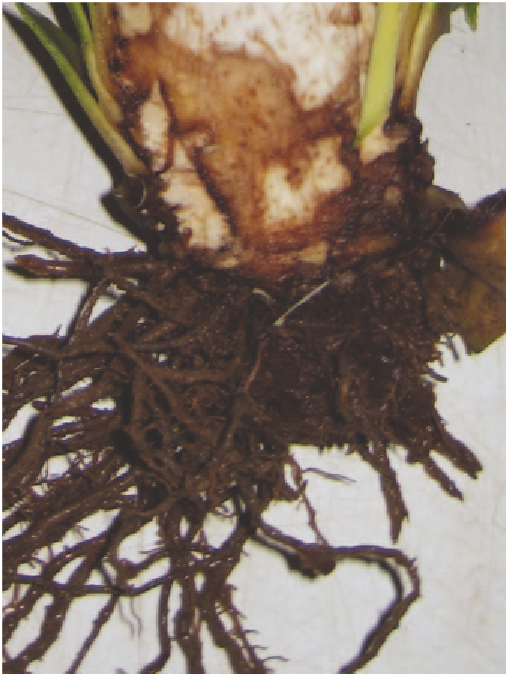Agriculture Reference
In-Depth Information
-
the careful use of plastic mulch to keep beds drier in
some circumstances; where plastic mulch is used, soil-
applied fungicides are of questionable value because
soil contact is reduced.
Phytophthora cinnamomi
becomes more active as soil pH
levels increase above 4.0. Liming materials, which raise
pH, should be used cautiously.
Phytophthora nicotianae
tends to be more active in soils with higher nutrient
status. Sulfur may be used to reduce pH in soils with a
pH above 5.5, but this is not a replacement for other
management practices.
•
PHYTOPHTHORA ROOT ROT
■
Cause
The oomycete
Phytophthora cinnamomi
, which also causes
heart rot and green fruit rot.
Fig 16.21 Roots destroyed by
Phytophthora
cinnamomi
(right)
compared with a healthy root system.
oxygen, and are not diagnostic. Leaves change in colour
from a healthy green through various shades of red and
yellow. Leaf tips and margins eventually become
necrotic. Once this happens, the root system is dead and
plants can easily be pulled from the ground. Fruit from
infected plants colour prematurely, are small and
unmarketable. Plants can recover if symptoms are
recognised early and remedial treatments applied.
However, if roots are killed right back to the stem, they
cannot regenerate.
Symptoms
The symptoms above ground are similar to those caused
by nematodes, mealybug wilt and low levels of soil
Source of infection and spread
See the section on heart rot. Root rot shows up first in
low-lying, poorly drained fields. Losses can be severe on
such soils, but plants on even relatively well-drained soils
can be affected during prolonged wet weather.
Importance
Losses from root rot can be serious in high rainfall areas
where prolonged rains extend into the winter months. The
disease can eliminate the ratoon crop.
Rough leaf varieties and some low acid hybrids are more
susceptible than Smooth Cayenne.
Management
See Phytophthora heart rot.
WATER BLISTER
■
Cause
The fungus
Chalara paradoxa
, which also causes butt
(base) rot and white leaf spot.
Fig 16.20 Roots on one side of the plant destroyed by Phytophthora
root rot. Also note infection in the stem.













